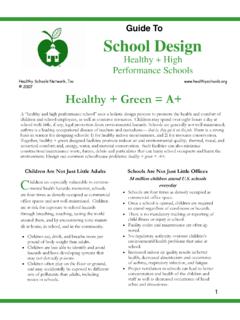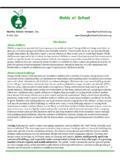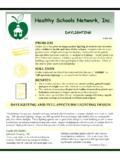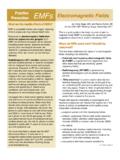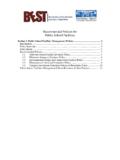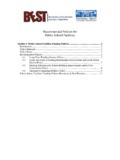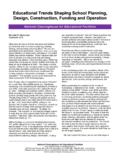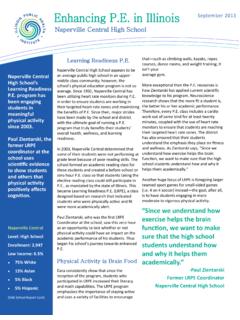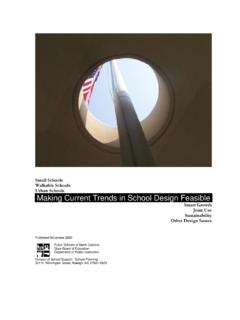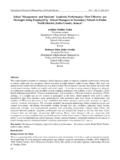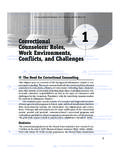Transcription of Eliminating Lead Risks - healthyschools.org
1 Healthy Schools NetworkEliminatingLead Risksin Schools and Child Care facilities :A Unitedand UrgentCall to Action for Children2018 AcknowledgmentsA collaborative workshop hosted byChildren s Environmental Health NetworkHealthy Schools NetworkLearning Disabilities Association of AmericaatThe Pew Charitable TrustsWashington, DC December 6-7, 2017 This report was supported by the Health Impact Project, a collaboration of the RobertWood Johnson Foundation and The Pew Charitable Trusts. Any opinions and conclusions expressed herein do not necessarily represent the views of contributingindividuals, organizations, or funders of the Health Impact Project.
2 DISCLAIMER: The opinions and conclusions expressed herein do not necessarily represent the views of any federal or state agency workshop attendees had the opportunity to review and comment on this report. To the best of the abilities of the co-hosts, it addresses all perspectives and represents themajor findings and conclusions of the Collaborators and Report Authors: Healthy Schools Network: Jeff Jones, Claire Barnett, Alex NaidooChildren s Environmental Health Network:Nsedu Obot Witherspoon, Kristie Trousdale Learning Disabilities Association of America:Maureen Swanson, Tracy GregoireEliminatingLead Risksin Schools and Child Care facilities :A Unitedand UrgentCall to Action for ChildrenWorkshop 1 APPENDICESA Workshop Agenda.
3 9B Workshop Attendees and Facilitator .. 12C Post-Workshop 14 DPresentation Summaries .. 15 EBreakout Group Expanded Summaries .. 19 FResources Recommended by Workshop 26 Table of ContentsPAGEPut children is a new urgency aboutreducing lead Risks to all children, especially those inschool and child care facilities . A renewed commitmentamong a national group of experts and advocates hasemerged to end the costly tragedy of lead poisoningthrough coordinated, comprehensive agree, there is no safe level of lead for children,particularly those six years and younger, a conclusionshared by the American Academy of Pediatrics (AAP), theAmerican Medical Association (AMA), the federal Centersfor Disease Control and Prevention (CDC), and the Protection Agency (EPA).
4 Indeed, no one,not even adults, is exempt from the effects of Blood Lead levels (EBL) in children contributeto IQ deficits and learning, behavioral, and attentionalproblems; adverse effects can occur at very low is in the process of reviewing a scientific recommendation to revise the blood lead reference value forchildren from 5 micrograms per deciliter to micrograms per deciliter. In recent decades, great strides in reducing lead exposure have been made by banning lead in gasoline and inmost paints. Yet lead remains pervasive in the environment. Lead in old paint and contaminated dust, especiallyin older homes and buildings, is the leading cause of EBL in children and has long been a target of , especially drinking water in homes, schools, and child care facilities , is another persistent source of leadexposure.
5 But many exposures remain unexamined and unaddressed, despite their quantifiable impacts on children shealth, learning, and behavior. For instance, lead in manufactured products and, increasingly, recycled goods isan emerging problem. In addition, crucial settingsof lead exposure have long been ignored, in particular schoolsand child care facilities , which enroll over 66 million childrenduring their developing years (50M in public and 5M inprivate PK-12 schools and over 11M ages five and under inchild care facilities ). These large group settings offer a majorbut largely untapped public health opportunity to preventlead Risks to large numbers of children at once, versus the current primary method of intervening one householdat a more is known about how even tiny amounts of lead canirreversibly harm children, it becomes important to addressadditional sources and settings of exposures, especially forthe poorest children, for children with poor diets, and for those whose health is already impaired.
6 They are amongthe most vulnerable lead Risks in PK-12 public and private schools (going forward, we ll simply call them schools) andlicensed and license-exempt child care (child care facilities ) was the focus of a facilitated workshop co-sponsoredand organized by Healthy Schools Network, the Children s Environmental Health Network, and the LearningEliminating Lead Risksin Schools and Child Care facilities :A Unitedand UrgentCall to Action for ChildrenIn his keynote address, Bruce Lanphear, MD, MPH,urged the group to focus on prevention at thepopulation level by removing lead hazards in theenvironment rather than testing individual childrenafter they have already potentially been exposed.
7 Southeastern PA elementaryschool withpeeling lead paint(J Roseman, AFT consultant)1 Disabilities Association of America. Held December 6-7,2017, at The Pew Charitable Trusts in Washington, DC, itincluded some 40 participants. They were experts in variedfields toxic chemicals, children s health, economics,education, environment, and public health who cametogether for the first time to learn, discuss, and mapnear-term steps in a comprehensive strategy for eliminatinglead exposure in schools and child care facilities . The workshop took place against the backdrop of newfederal efforts on lead, including a 2016 updated inventoryof federal lead prevention programs.
8 A study by economistCorwin Rhyan, one of the keynote speakers, recognizes thatlead poisoning of children is preventable and thateliminating all exposures to lead could save the nation asmuch as $84 billion annually. With these factors in mind,participants created an urgent public-private strategy toaddress all sources of lead in schools and child care facilities . Following is the list of workshopfindings that informed this strategy: No amount of lead is safe for any poisoning is preventable. Children of color and children from low-incomecommunities experience greater exposures to leadhazards than other children. Lead poisoning of American children is an urgent issuecosting the nation as much as an estimated $84 poisoning erodes our future as an economicallycompetitive nation.
9 Public- and private-sector agencies and entities mustwork together to end Risks of lead in school and childcare facilities . There are existing programs and campaigns to build onor expand and new strategic efforts that must be takenup. Lead embedded in paint, water, products, andequipment associated with school and child carefacilities must be addressed with united advocacycampaigns, new public and private resources, and newfederal and state programs. This report documents participants goals and plans to eliminate lead Risks , focused on the need to: develop a strategic framework to eliminate lead Risks in schools and child care environments,draft implementation plans and identify activities that can be collectively advanced, and motivate participants to work together toward this common agenda.
10 Workshop at work. Standing at left:Bill Hudson and Bruce Rumpler, Environment America: I was inspired to meet so many talented andcommitted advocates and researchers in oneroom. Now let s roll up our sleeves and convincepolicymakers to get the lead out wherever our children go to learn and play every day. In his keynote address, health economistCorwin Rhyan described a recent studyindicating that lead-poisoned children may cost the nation as much as $84 billion eachyear, measured in terms of future earnings, as well as additional education, health, andincarceration costs. This means the nation couldsave $84B every year if it could eliminate allsources of lead exposures to groups then developed and shared a proposed set of actions that could be undertaken to achieve these goals.
